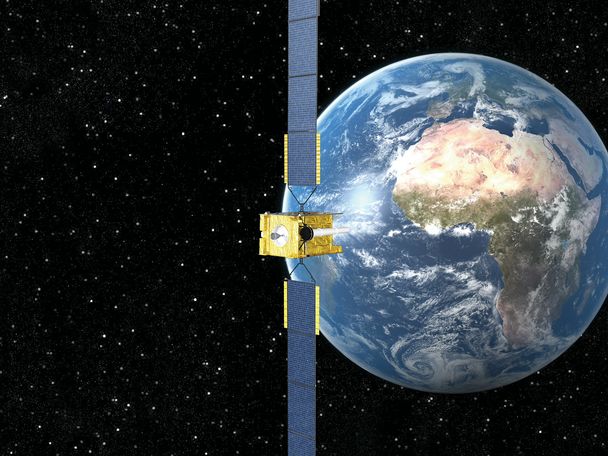The Impact of MILSATCOM Innovation in today’s combat warfare

The Impact of MILSATCOM Innovation in today’s combat warfare
Nick Bolan (Solution Lead for Future UK MILSATCOM) gives his opinion on the challenges and opportunities facing the Milsatcom domain and the role that Airbus is playing in leveraging innovation to support defence today and in the future.
We discuss trends around milsatcom innovation in ensuring competitive advantage and Airbus’ role in delivering cutting edge technology in support of our customer’s future milsatcom requirements.
The future of Milsatcom
Military satellites perform an essential role in modern military communication, securely connecting strategic, operational and tactical domains anywhere on the globe. Despite the rapid growth of networking technologies, satellite communication remains the corner stone of delivering assured beyond-line-of-sight (BLOS) connectivity. But whereas early generations of this technology largely relied on geostationary narrowband UHF satellites as a means of providing resilient comms, the requirements of the modern war fighter are forcing the most significant step changes in Milsatcom in over 50 years.
Today, if we are to empower our troops to remain one step ahead of our adversaries, then more data hungry assets are needed to ensure operational advantage. Greater integration is needed to enable effective cross domain intelligence. This in turn demands exploration and utilisation of higher frequencies and transmission processing technologies in order to provide bandwidth that can process vast quantities of data. If the future aspirations of the Ministry of Defence (MoD) and military forces are to be realised, we also need to consider how we might harness advances in technology coming from the commercial satellite sector.
Balancing legacy and future technology
The innovations we’re seeing within this field in the shape of commercial ventures is some of the most exciting this sector has seen in recent years, but while these developments offer new opportunities, we must recognise that their value comes through the layered benefits that can be achieved through integration with core Milsatcom solutions.
A great example of this is the military use of UHF. Once seen as cutting edge technology, today we are starting to see its limitations in terms of throughput – generally speaking, an autonomous drone looking to offload full motion videos simply couldn’t be supported using the relatively limited bandwidth afforded by UHF. However, when considering the PACE (Primary, Alternate, Contingency and Emergency) communications needed for individual missions, then the resilience and assurance that UHF provides cannot currently be bettered. Fundamentally, within the Milsatcom domain the need for tactical voice comms to support the disadvantaged user remains vital and therefore legacy technology will continue to play a role for the foreseeable future.
Growth of commercial space sector
Part of the growth we’ve seen in commercial space comes from a reduction in the traditional costs associated with accessing and operating in this domain. Companies such as SpaceX are reducing launch costs and driving market growth, creating a ubiquitous commercial satcom capability though Starlink and, of course, OneWeb in the UK. In addition to this, the opportunity to develop dynamic payloads that can be configured and upgraded once in orbit provides a significant advantage in overcoming on-board technical obsolescence.
But while the growth we’re seeing in commercial space presents opportunities, it also needs to be carefully assessed against the unique demands of military operations. As a military fighting force, a nation needs to have ownership and absolute control over what it does with its assets – milsatcom is no exception. The freedom to command and control satellite networks in order to operate with absolute authority is imperative to mission success.
But the military also needs agility and flexibility. The pace of innovation in the commercial space sector challenges that of the military, and if we are to achieve the step change required to deliver multi-domain integration, the data hungry assets which will underpin this approach must consider how they take advantage of commercial satellite technologies and satellite networks. This will give the UK MoD and its fighting forces the opportunity to retain a core foundational pillar of highly resilient GEO sovereign owned and operated systems with full design autonomy, while at the same time providing them with the opportunity to harness the benefits of new and emerging technologies and solutions.
Integration – the force multiplier
However, while that may sound simple to achieve on paper, experience tells us that the reality is often very different. Because while integrating commercial technology into a milsatcom portfolio provides huge theoretical benefits - cost competitive bandwidth on demand, coupled with more nodes in the network to provide the user with resilience through diversity - if this is not approached intelligently and with a focus on holistic systems integration which places the user at the heart of system management and control, it will simply add additional layers of complexity to a capability which is already extremely complicated.
In order to truly leverage the benefits of an integrated sovereign, allied and commercial network, thorough consideration must be given to how end to end network management and control can be delivered to remove air gaps between disparate Network Management Systems and abstract multiple layers of technology in order to allow the military user to focus on understanding how to dynamically optimise the system at a pace which outperforms an adversary.
This integration piece – an area Airbus has been concentrating on for some time – is coming sharply into focus for many military capability owners.
How do we, at a technical level, take technologies like inter-satellite linking between GEO and LEO constellations, and integrate these into a collaborative end to end architecture? How do we bring both military and commercial assets together in a coherent, well-orchestrated way? How do we ensure that the user experience is not only seamless and immediately intuitive, but that the training burden is minimised?
As a systems integrator, Airbus has decades of experience in developing, delivering and managing complex networks on behalf of its customers. Intelligent integration is a critical force multiplier.
Understanding the customer requirements
It’s clear that the pace of innovation we’re seeing from both the commercial and defence sectors has the potential to deliver an integrated portfolio of solutions which complement one another to achieve a balanced approach to customer requirements. But for these capabilities to be delivered intelligently and with an eye on through life costs, the MoD need to work with organisations who can help develop, grow and implement this approach. Airbus are in the privileged position of being able to understand both the breadth of customer requirements and the opportunity to integrate complementary technologies across multiple sectors which can fulfil these needs. Our focus on future technologies allows us to deliver the immediate needs of the customer while horizon scanning to ensure that, when these requirements evolve, emerging technologies and capabilities can be integrated seamlessly into their existing portfolio.
This approach absolutely echoes the ethos and end to end thinking Airbus championed whilst delivering the Skynet PFI to the MoD. With collaboration and active engagement at the heart of this relationship, we were able to consistently deliver on immediate operational requirements while staying agile in the face of evolving needs. As a manufacturer, we have a unique perspective across the entire value chain – from design to build to operation. This enables us to deliver compelling and cutting edge solutions to commercial network operators. As an operator, it enables us to deliver the highest levels of service and agility to respond to emerging demands, and as a systems integrator, we ensure all of the elements work seamlessly together to a cohesive and coherent whole.
As the UK makes strides toward a fully integrated military communications network, satellite communication will undoubtedly remain a cornerstone of this capability. With our experience as an operator of both military and commercial satellites, Airbus is ideally positioned to support the MoD and military forces, helping to ensure they remain at the cutting edge of sovereign milsatcom technology, today and tomorrow.
Your contact

Nick Bolan
MilSatCom - Solution Lead for Future UK MILSATCOM